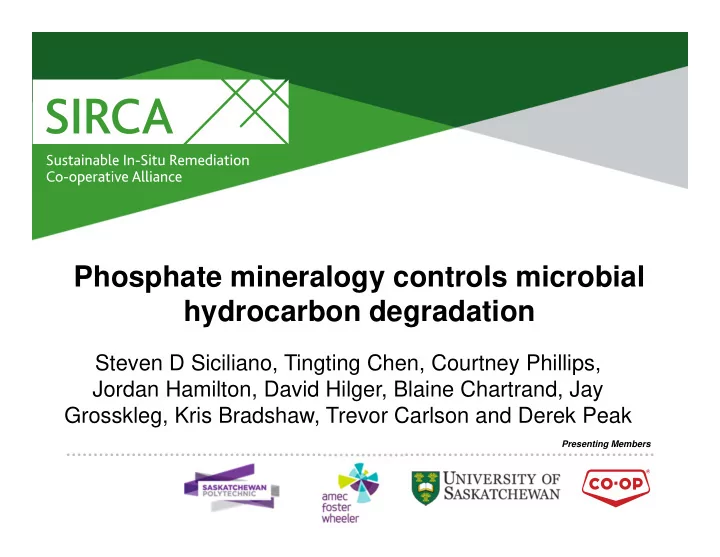

Phosphate mineralogy controls microbial hydrocarbon degradation Steven D Siciliano, Tingting Chen, Courtney Phillips, Jordan Hamilton, David Hilger, Blaine Chartrand, Jay Grosskleg, Kris Bradshaw, Trevor Carlson and Derek Peak Presenting Members Integrity Excellence Responsibility
Why did your remediation stall? • The soils are full of clay. • The soils freeze. • The soils have fractured flow.
How to remediate hydrocarbons in two easy steps 1.Supply electron acceptors (oxygen, nitrate, iron, sulfate) 2.Supply the building blocks that microbes need to grow (nitrogen, phosphorus)
Phosphate Fate in Soil during Biostimulation Microbial Uptake for Adsorbing on Mineral bioremediation Surfaces -2 HPO 4 Transport (aq) (macro and micro scale) Forming New Minerals
It logically follows that if microbes need phosphorus then…… If sorption controls phosphorus reactivity. In soils, this really means mineralogy dictates sorption which controls phosphorus reactivity. Microbes require phosphorus to degrade hydrocarbons. In soils, this really means that mineralogy sways microbial hydrocarbon degradation.
Hypotheses Biostimulatory solutions worked at some sites but not others due to variation in phosphate speciation, whereas site ‐ specific effects not linked to phosphate are secondary.
Site History
Remedial Approach: Large (1m) bore 5.5m infiltrators
2013 Activities – Infiltrator Installation
2013 Activities – Infiltrator Installation
Biostimulatory Solution • circumneutral pH • 11 mM MgSO 4 , • 1 mM H 3 PO 4 , • 0.08 mM HNO 3 in potable water. Concentrations were selected to: 1. match local groundwater sulfate, 2. be at the maximum allowed concentration of nitrogen, 3. be below solubility for any phosphate mineral formation. It was pumped into the infiltrators 0.5 m below ground at a flow rate of approximately 5000 L/day.
Step 1. Alter soil mineralogy Collect Soils from 8 Different Contaminated Sites Nothing Amorphous Natural Crystalline Hematite Hydroxyapatite Phosphorus Phosphorus Phosphorus Least soluble (crystalline Most soluble phosphorus minerals) (adsorbed Phosphorus)
2014 Activities – Soil Sample Placement • Amendment delivery began on August 14 th , 2014 • Premade soil bags placed in the infiltrators August 22 nd
Step 2. Amend with orthophosphate for six months Amorphous Natural Crystalline Hematite Hydroxyapatite Phosphorus Phosphorus Phosphorus Aerobic & Anaerobic Mineralization 1. Diesel dissipation Living 2. Degradation gene prevalence Diesel Degraders 3. Community Structure
Pulling the Soils Back Out
After 3 months all 8 different sites had responded to the biostimulatory solutions.
Calcite was dissolved when we acid washed, but there was no consistent effect on the pools of phosphorus in these soils
Three principal phosphate phases formed: a) Adsorbed phosphate b) Brushite (CaHPO 4 ∙ 2H 2 O) c) Newberyite (MgHPO 4 ∙ 3H 2 O)
What was more important: mineralogy or phosphorus adsorption? Indicator Type Mineralogy Phosphate Adsorption Catabolic Genes Non ‐ significant P < 0.05 Mineralization Assays Non ‐ significant P < 0.10 But remember that mineralogy and Culturable Diesel Degraders P < 0.01 P < 0.01 BTEX Degradation Rate P < 0.04 Non ‐ significant phosphate adsorption are not CCME F1 Degradation Rate P< 0.01 P < 0.01 independent; rather it is what dominated in our system.
Anaerobic phenanthrene degradation and the catabolic gene bzdN were promoted by adsorbed phosphorus.
Mineralogy influences microbial community composition.
Microbial community composition influences degradation.
Take Home Messages 1. Total amount of adsorbed phosphate controls hydrocarbon degradation. 2. Relative proportions of adsorbed versus mineral phosphorus controls community composition. Integrity Excellence Responsibility
Site Management Lessons Hydrocarbon Degradation Total Phosphorus Phenotype Microbial Community Composition Relative Proportions Genotype Carbonate Excess bzdN Hydrocarbon Newberyite Phosphorus (denitrifiers) Stall Dissolution Thus, small amounts of phosphorus injected in the subsurface will increase degradation but large amounts may inhibit degradation. Integrity Excellence Responsibility
Recommend
More recommend